Can't See the Wood for the Trees

Vega
Hugh and Annie
Sun 27 Mar 2016 00:07
16:13.16N 62:28.13W When we first arrived in Guadeloupe and anchored at Deshaies (pronounced deyhey) we were close to the wooded slopes of the north side of the bay. It was strange because although it was hot it felt more like the Quantocks or Exmoor on a sunny winter’s day. And then I noticed that the trees on the nearby slopes were leafless and indeed looked just like the winter oaks in my imagined woods. Having been walking in the rainforest on St Kitts and then Nevis I had assumed that everything out here was evergreen, the only real difference between the seasons being the amount of rainfall. Not so, it would appear. A significant factor also seems to be altitude. The tops of the mountains (volcanos) are almost constantly shrouded in cloud and it is windy up there. The middle slopes receive heavy rain showers at this, the dry time of year and are hot. The lower slopes and coastal areas are hot and may receive frequent rainfall if on the downwind side of the island or be quite dry if on the upwind side. I would Google for a more informed view but poor wifi (it really is hopeless out here) means that my assessment is rather more speculative than would ideally be the case. Anyway, the woodland on the low slopes can be deciduous and when we anchored in a beautiful quiet spot by the Islet a Cabrit in the Isles des Saintes we were struck by the verdant green of the leaves. Closer inspection revealed that the whole islet is covered in deciduous woodland and it now appears to be the Caribbean spring - hence the freshness of the green. The Islet hosts feral goats so there is little in the way of understory and ground cover plants beneath the trees. However, on the main island of Terre de Haut in the Saintes the ground cover includes cacti. Cacti and deciduous trees, a very weird combination! We have discovered that most of the flowering shrubs we have seen, such as the bougainvillea and hibiscus are, like the coconut palms, bananas and sugar cane imports from elsewhere. I wonder, therefore, whether the cacti are endemic or imported. What about the deciduous trees? I do wish the internet was more accessible.As an aside, on the island of La Gomera in the Canaries we noticed a similar marked change in the vegetation with altitude. There it is much drier than in the Caribbean. At sea level it is almost desert like with cacti and so on, no trees. As you rise it becomes cooler and wetter until at the top of the volcano it is temperate rainforest. Similarly in Morocco where as you drive across the Atlas mountains from the north you leave dry barren land and date palms at the bottom, pass through seasonal deciduous woodland at the top and head back down into date palms and the Sahara on the southern side. On Nevis and St Kitts we had enjoyed our walks through the rainforest. No hint of anything deciduous there. However, the forest was rather dark and a bit gloomy. The only understory plants we saw were large versions of the palms and cheese plants that are grown indoors at home in the UK. There were birds singing in the tree tops and on Nevis strange bats with enormous wings that they slowly flapped - making them look like large black butterflies (our guide referred to them as “Butterfly Bats”). However, what I have been keen to see are humming birds and have therefore been looking for the flowers they might feed on. On Antigua at the marina I had seen an olive green humming bird feeding on a shrub with large bright yellow flowers. The same shrub is widely used for ornamental purposes along with the hibiscus and bougainvillea, neither of the latter two appearing to have nectar in their flowers. We hadn’t seen any wild flowers outside the garden areas and certainly not in the rainforest. The lack of flowering plants was a mystery until we arrived back in Guadeloupe and drove into the rainforest that still covers much of the island. There are waterfalls in the forest that are popular spots to visit and swim and the first we visited involved a 30 minute walk through the forest. Compared with Nevis there was much more sunlight coming down through the trees and lots of understory plants some of which had amazing flowers. It was like being in a terrarium of exotic flowering houseplants. One in particular had flowers that looked like a bright red artichoke and as I was photographing one a black humming bird darted in, saw me and left as quickly as it had arrived. I did get a picture though….. Things were looking up on the humming bird front. The waterfall we were making for turned out to be worth the walk. In a beautiful forest clearing was a large steep sided pool with the waterfall at the far end - the kind of scene you see romantically and probably naaively painted with scantily clad native people swimming and sitting around the edge (we have seen this very picture hanging in both a museum and tourist shops). There were people swimming but not us as we had to move on to our next waterfall. This was near the main road across the national park and a popular visitor attraction. At the car park was a gift shop and cafe and as we sat drinking our coffees we were surrounded by Trembler Birds with piercing bright orange eyes and trembling wings, just like baby sparrows wanting to be fed. In the undergrowth next to us we could see a mongoose rummaging around. There were bright red flowers on some shrubby plants including one right by our feet. As we were watching the mongoose, a humming bird, that was a deep red colour on its neck and head and bright blue on its body and wings, came and hovered by our feet as it fed at the red flower. Sadly, despite my vigorous pointing and urging, Annie with the camera was too slow on the uptake and I am not sure if she even saw it, never mind take a photograph. The second waterfall was as lovely as the first and this time Annie swam and enjoyed the cool water and exhilarating splash of the falling water. Someone had to stay on the side and take photographs and I reluctantly volunteered. Our next destination was the Soufriere volcano at the southern end of the island. We didn’t have time for the hour and a half walk to the top but the road took us high enough that a 20 minute walk would get us up into the cloud layer. By now the light was fading. With the wind in the trees and chirruping of frogs it was a bit spooky. As we reached the cloud layer that permeated the trees we emerged from the forest onto the north coast of Cornwall. The trees had given way to windswept shrubby vegetation very reminiscent of the Cornish coast on a cloudy, windy day. The cloud is partially sulphurous smelling steam that comes out of the ground and this added to the strange atmosphere. We followed the old road (now closed due to rockfalls) back down to the car park and on the way down noticed that the forest was full of ferns, palms and what looked like bird of paradise plants except that the flowers are red rather than the orange and mauve you see everywhere in the Canaries and as house plants in the UK. Adjoining the car park was my kind of pool - one constructed to hold the warm spring water flowing out of the volcano and this time I volunteered to do the swimming. It was so wonderful Annie couldn’t resist a dip as well. As we were were floating around in the warmth and gloom I noticed a big sign next to the path saying something about not putting your head under the water. Later investigation revealed a warning about amoeba that live in fresh water warmer than 25 degrees C and that enter the body through the mucous membranes of the nose and mouth. We were reassured that only a few hundred people had died world wide but noted that, once harboured, the amoeba invariably resulted in death. Our noses itched and tingled all the way back to the boat. 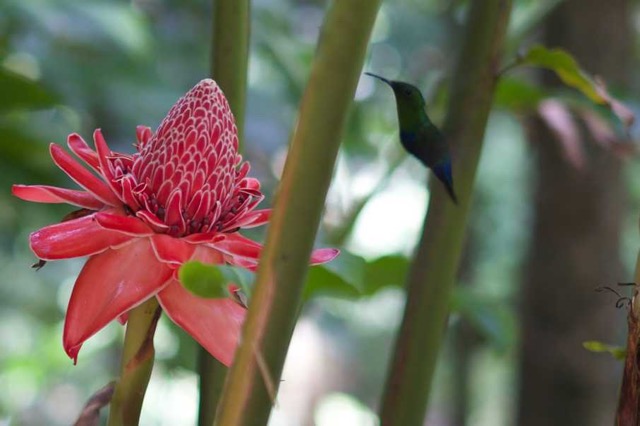 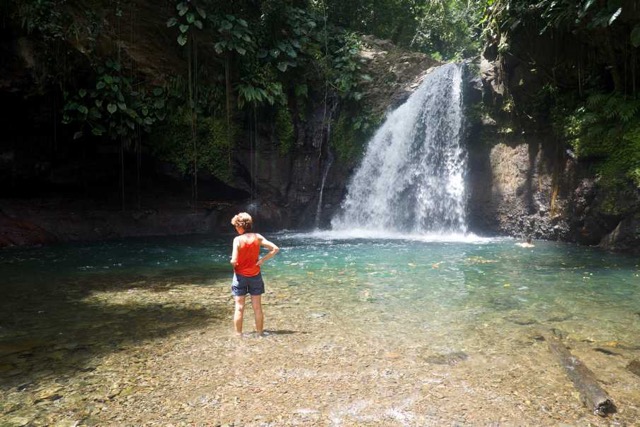 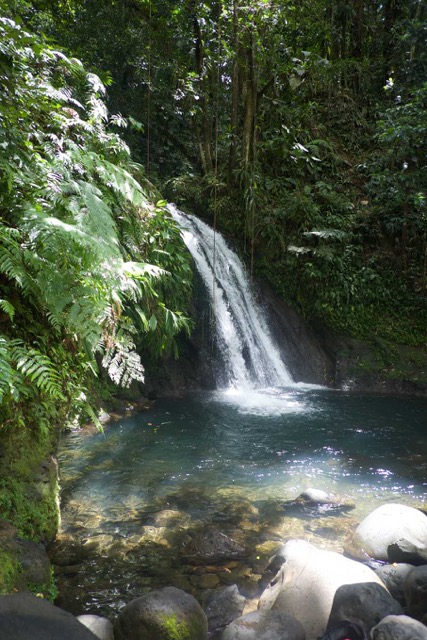  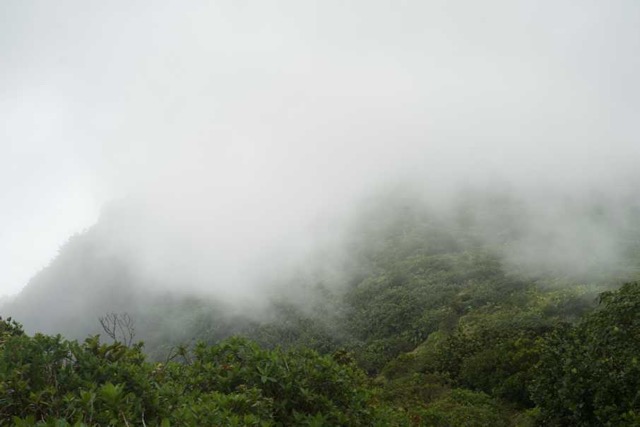 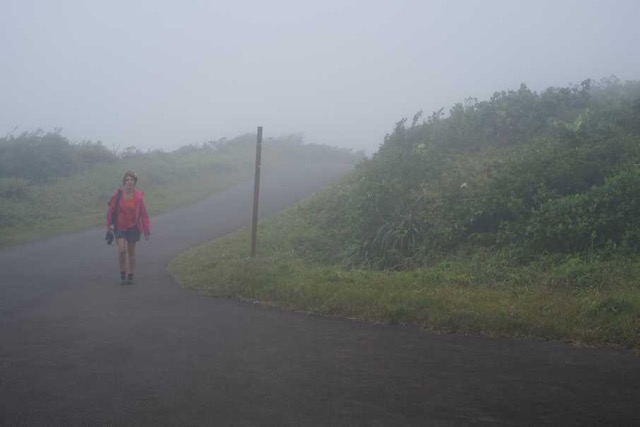  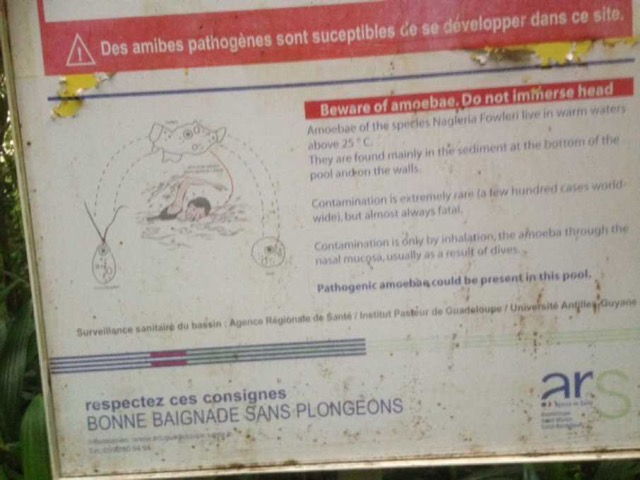 |